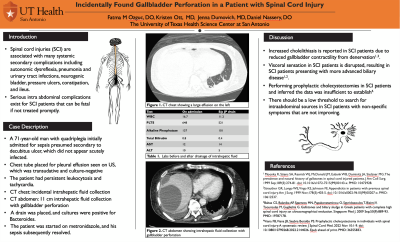Tuesday Poster Session
Category: Biliary/Pancreas
P2962 - Incidentally Found Gallbladder Perforation in a Patient With Spinal Cord Injury
Tuesday, October 24, 2023
10:30 AM - 4:00 PM PT
Location: Exhibit Hall

Has Audio

Fatma Ozguc, DO
UTHSCSA
San Antonio, TX
Presenting Author(s)
Fatma Ozguc, DO, Jenna Dumovich, MD, Kristen Ott, MD, Daniel Nassery, DO
UTHSCSA, San Antonio, TX
Introduction: Spinal cord injuries (SCI) are associated with numerous systemic secondary complications corresponding to the affected nerve distribution. Although not routinely discussed, there is literature describing increased frequency of gallbladder pathology in SCI patients that can lead to fatal complications if not diagnosed promptly1. Here we present a unique case of incidentally discovered gallbladder perforation as a source of sepsis in a SCI patient.
Case Description/Methods: A 71-year-old male with C1-C4 complete quadriplegia after a SCI in 2015 was admitted for sepsis with an initially presumed source to be his decubitus ulcer complicated by osteomyelitis. However, the wound was chronic and did not appear to be acutely infected. He was also found to have a loculated pleural effusion on point of care ultrasound (POCUS) and underwent chest tube placement. Fluid studies indicated transudative effusion and cultures remained negative. The patient continued to remain septic demonstrated by rising leukocytosis and tachycardia. Computed tomography (CT) chest that was obtained to evaluate the complicated pleural effusion incidentally showed an intrahepatic fluid collection. Abdominal exam was unremarkable. Subsequent CT abdomen and pelvis showed an 11cm intrahepatic fluid collection communicated with a single point gallbladder perforation. Jackson-Pratt (JP) drain was placed, and cultures were positive for Bacteroides. Metronidazole was started with complete resolution of sepsis.
Discussion: Gallbladder pathology should be considered as a source of sepsis in patients with SCI even in the absence of conventional symptoms and physical exam findings. The etiology for the increased rate of gallbladder disease within this demographic is currently not well understood but could be related to impaired sympathetic nervous system (SNS)1, chronic inflammation, and/or decreased physical activity. Disrupted SNS in SCI patients can lead to unusual and more advanced biliary disease on presentation. Intrahepatic complications like cholecystitis can be fatal if not treated promptly. Hence, there should be a low threshold to search for intraabdominal sources in SCI patients who are not improving with current medical management.
1Moonka R, Stiens SA, Resnick WJ, McDonald JM, Eubank WB, Dominitz JA, Stelzner MG. The prevalence and natural history of gallstones in spinal cord injured patients. J Am Coll Surg. 1999 Sep;189(3):274-81. doi: 10.1016/s1072-7515(99)00143-x. PMID:10472928.
Disclosures:
Fatma Ozguc, DO, Jenna Dumovich, MD, Kristen Ott, MD, Daniel Nassery, DO. P2962 - Incidentally Found Gallbladder Perforation in a Patient With Spinal Cord Injury, ACG 2023 Annual Scientific Meeting Abstracts. Vancouver, BC, Canada: American College of Gastroenterology.
UTHSCSA, San Antonio, TX
Introduction: Spinal cord injuries (SCI) are associated with numerous systemic secondary complications corresponding to the affected nerve distribution. Although not routinely discussed, there is literature describing increased frequency of gallbladder pathology in SCI patients that can lead to fatal complications if not diagnosed promptly1. Here we present a unique case of incidentally discovered gallbladder perforation as a source of sepsis in a SCI patient.
Case Description/Methods: A 71-year-old male with C1-C4 complete quadriplegia after a SCI in 2015 was admitted for sepsis with an initially presumed source to be his decubitus ulcer complicated by osteomyelitis. However, the wound was chronic and did not appear to be acutely infected. He was also found to have a loculated pleural effusion on point of care ultrasound (POCUS) and underwent chest tube placement. Fluid studies indicated transudative effusion and cultures remained negative. The patient continued to remain septic demonstrated by rising leukocytosis and tachycardia. Computed tomography (CT) chest that was obtained to evaluate the complicated pleural effusion incidentally showed an intrahepatic fluid collection. Abdominal exam was unremarkable. Subsequent CT abdomen and pelvis showed an 11cm intrahepatic fluid collection communicated with a single point gallbladder perforation. Jackson-Pratt (JP) drain was placed, and cultures were positive for Bacteroides. Metronidazole was started with complete resolution of sepsis.
Discussion: Gallbladder pathology should be considered as a source of sepsis in patients with SCI even in the absence of conventional symptoms and physical exam findings. The etiology for the increased rate of gallbladder disease within this demographic is currently not well understood but could be related to impaired sympathetic nervous system (SNS)1, chronic inflammation, and/or decreased physical activity. Disrupted SNS in SCI patients can lead to unusual and more advanced biliary disease on presentation. Intrahepatic complications like cholecystitis can be fatal if not treated promptly. Hence, there should be a low threshold to search for intraabdominal sources in SCI patients who are not improving with current medical management.
1Moonka R, Stiens SA, Resnick WJ, McDonald JM, Eubank WB, Dominitz JA, Stelzner MG. The prevalence and natural history of gallstones in spinal cord injured patients. J Am Coll Surg. 1999 Sep;189(3):274-81. doi: 10.1016/s1072-7515(99)00143-x. PMID:10472928.
Disclosures:
Fatma Ozguc indicated no relevant financial relationships.
Jenna Dumovich indicated no relevant financial relationships.
Kristen Ott indicated no relevant financial relationships.
Daniel Nassery indicated no relevant financial relationships.
Fatma Ozguc, DO, Jenna Dumovich, MD, Kristen Ott, MD, Daniel Nassery, DO. P2962 - Incidentally Found Gallbladder Perforation in a Patient With Spinal Cord Injury, ACG 2023 Annual Scientific Meeting Abstracts. Vancouver, BC, Canada: American College of Gastroenterology.
